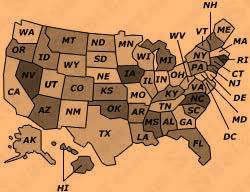 *Mr. Sullivan is a retired Army Reserve JAG colonel. He practices family law in Raleigh, North Carolina and is the author of The Military Divorce Handbook (Am. Bar Assn., 3rd Ed. 2019) and many internet resources on military family law issues. A Fellow of the American Academy of Matrimonial Lawyers, Mr. Sullivan has been a board-certified specialist in family law since 1989. He works with attorneys nationwide as a consultant on military divorce issues in drafting military pension division orders. He can be reached at 919-832-8507 and at law@ncfamilylaw.com.
*Mr. Sullivan is a retired Army Reserve JAG colonel. He practices family law in Raleigh, North Carolina and is the author of The Military Divorce Handbook (Am. Bar Assn., 3rd Ed. 2019) and many internet resources on military family law issues. A Fellow of the American Academy of Matrimonial Lawyers, Mr. Sullivan has been a board-certified specialist in family law since 1989. He works with attorneys nationwide as a consultant on military divorce issues in drafting military pension division orders. He can be reached at 919-832-8507 and at law@ncfamilylaw.com.
Introduction
From time to time, our office gets inquiries by phone or e-mail regarding how to estimate the military retired pay of a member of the uniformed services. This term means the “armed forces,” that is, the Army, Navy, Air Force, Marine Corps, and Coast Guard, and also the commissioned corps of the Public Health Service (PHS) and the National Oceanic and Atmospheric Administration (NOAA). The rules for calculating the retired pay of the active-duty “member” one of these service components, technically called “Regular Retirement” pay, are set out in 10 U.S.C. § 1407 and 1409 for the armed services, and at equivalent sections of the U.S. Code for PHS and NOAA officers. Below is a simplified explanation of the rules for calculation.
“What’s the Formula?”
The basic formula for determining one’s retired pay is Retired Pay Base times Retired Pay Multiplier, or RPB X RPM. This can be illustrated as:
The usual percentage is 2.5%, but it’s 2.0% when a) the servicemember elected to receive a mid-career cash bonus known as CSB/Redux, or when b) the member is in the Blended Retirement System.
High-3 Pay
“High-3 Pay” is the average of the highest three years (not necessarily continuous) of base pay for a member, expressed on a monthly basis.
- How to obtain the documents and do the calculations is set out in the Silent Partner infoletter, “Military Pension Division and the Frozen Benefit Rule: Nuts ‘n’ Bolts,” found at nclamp.gov > Publications.
- The quick way to estimate this is to take the current pay of the member, obtained from his or her Leave and Earnings Statement, or “LES” (or other equivalent pay statement, such as the “PaySlip” for Coast Guard member), and multiply it times 98%. Thus if Major Jane Doe receives $8,000 per month as her base pay, the estimate for her High-3 Pay would be $8,000 X .98% or $7,840.
The Defense Finance and Accounting Service (DFAS) is the pay center for the Army, Navy, Air Force and Marine Corps. The Department of Defense regulation governing the Privacy Program, DoD 5400.11-R, states that the Defense Department will release the following information regarding a servicemember: date of rank, gross salary, length of military service and Basic Pay Entry Date. Para. C4.2.2.5.2.1, DoD 5400.11-R (May 14, 2007). Other items may also be disclosed.
Years of Service
“Years of service” can be determined by asking Major Jane Doe, if she is your client. Otherwise the figure can be determined by review of her LES (look at the “Pay Date” or “Pay Entry Base Date” as well as the DIEMS, or Date Initially Entered Military Service). The LES may be provided voluntarily by Jane or her attorney, or it may be obtained otherwise through discovery. This information is also available through a request pursuant to DoD 5400.11-R, as noted above. If you know Jane’s pay grade[2] and years of service, you can determine her present base pay by using the pay tables at the DFAS website, https://www.dfas.mil > Military Members.
Pay grade – not rank – is what’s needed for the pay tables. Rank can be confusing: a master sergeant in the Air Force is pay grade E-7, but it’s E-8 in the Army; a Navy captain is pay grade O-6, but a Marine Corps captain is pay grade O-3!
Example of the Calculation
Let’s follow up on the calculations for Major Jane Doe, with the data set out above. Her “estimate” for the High-3 is $7,840, and her Retired Pay Multiplier (assuming that she has just finished serving 20 years) is 20 X 2.5%, or 50%. The combination of these gives $3,920/mo. This is the projected retired pay for Major Doe if she were to retire at the 20-year mark with the above as her High-3 pay.















